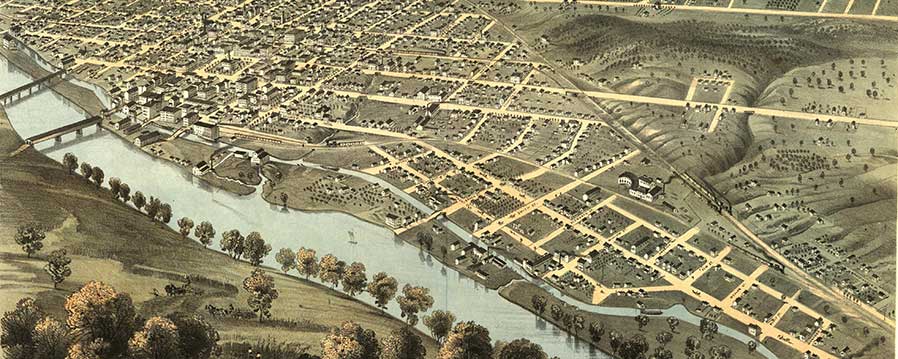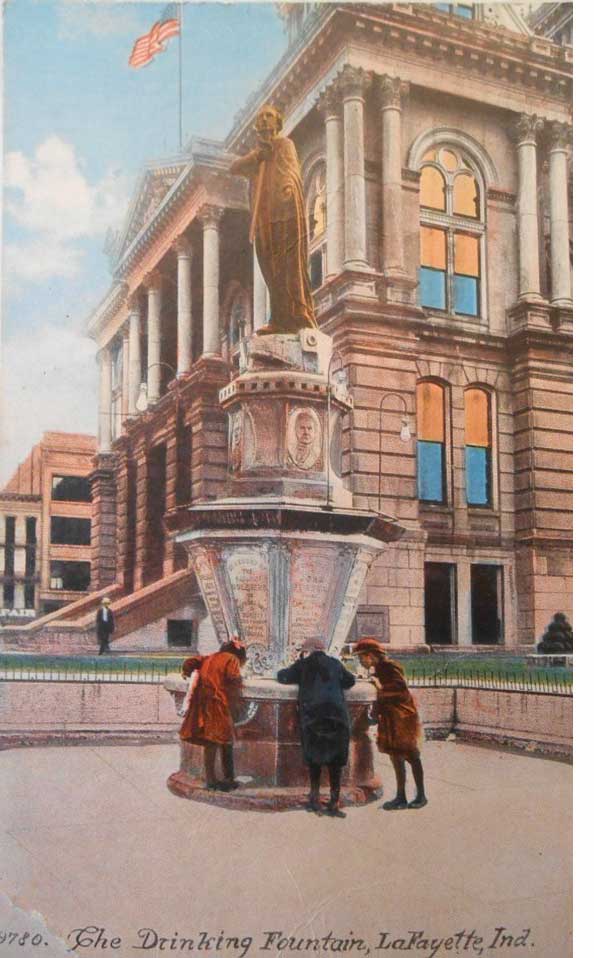Area History
Lafayette History
Lafayette is a city in and the county seat of Tippecanoe County, Indiana. It's located 63 miles northwest of Indianapolis and 108 miles southeast of Chicago.

The Native Americans were the first to discover the beauty of this Wabash Valley. The Wea, Miami, Potawatomi, Shawnee, Wyandot, Winnebago and Delaware were some of the tribes that settled here. In 1717 the French government established Fort Ouiatenon across the Wabash River and three miles south of present-day Lafayette. The fort became the center of trade for fur trappers, merchants and Indians.
Tecumseh and his brother, the Prophet, arrived to try and preserve the Native American way of life. They established the headquarters for their confederation at Prophetstown and this led to the Battle of Tippecanoe in 1811. In the years following the War of 1812, Indiana joined the Union on December 11, 1816, becoming the 19th State.

The settlers arrived here on the banks of the Wabash. One of these early settlers was William Digby. He was a young man, just starting in life. He made his living as a riverman and he knew that this was about as far upriver as the new steamboats were going to be able to travel. He went to the 1824 Christmas Eve land sale in Crawfordsville and bought the land to establish a town. He platted it in May of 1825 and named it after the Marquis de Lafayette, the French hero of the Revolutionary War.
Lafayette became the supply center for these new settlers moving into the area. In 1826, Tippecanoe County was formed with Lafayette as its county seat. The river provided transportation in those early years, with the city wharf just a block from the Courthouse Square. In the 1840s, the Wabash & Erie Canal arrived. By the 1850s the railroads had arrived to serve the developing town. Lafayette was soon a manufacturing, merchandising, and transportation center.
In its earliest days, Lafayette was a shipping center on the Wabash River. In 1838, Henry Leavitt Ellsworth, the first United States Patent Commissioner, published a booklet titled Valley of the Upper Wabash, Indiana, with Hints on Its Agricultural Advantages, to promote settlement of the region. By 1845, Ellsworth had purchased 93,000 acres of farmland in and around Lafayette and moved here from Connecticut to supervise land sales. By 1847, Ellsworth was distributing broadsides looking for farmers to purchase his farmland. He became president of the Tippecanoe County Agricultural Society in April 1851. Ellsworth Street and Ellsworth Historic District are named for the early real estate developer.

In the 1840s, the Wabash and Erie Canal stimulated trade and affirmed Lafayette's regional prominence. Railroads arrived in the town in the 1850s, connecting it with other major markets. The Monon Railroad connected Lafayette with other sections of Indiana.
In August of 1859, Lafayette became the site for the first official air mail flight by the United States Postal Service. Professor John Wise and his balloon, the Jupiter, took off with a mail pouch including 123 letters and 23 circulars. Because of a capricious wind that blew south, the flight ended near Crawfordsville some 5 or 6 hours later. While this was not the intended destination, the flight was officially recognized. In 1959, the U.S. Postal Service issued a 7¢ airmail stamp commemorating the centennial of the event
Lafayette continued to grow and in 1869, Purdue University was founded. The school has played an important part in the development of the Lafayette-West Lafayette area. Today, Lafayette has developed as a diversified community with manufacturing, merchandising, education and transportation all contributing their share.
We are proud that Purdue University is known as home of the astronauts, but even as we look to the future, we continue to honor our past by preserving our architecture and historical heritage. Because of this attitude, Lafayette has won several national awards including "All American Main Street".
WEST LAFAYETTE
West Lafayette is a city in Tippecanoe County and it is located about 65 miles northwest of the state capital of Indianapolis and 106 miles southeast of Chicago. West Lafayette is directly across the Wabash River from its sister city, Lafayette.

James Suit was probably the first settler in Wabash Township where West Lafayette is located. He came about 1822 and would load keel boats with honey and pelts, then float to Vincennes and trade for supplies needed by other early settlers. One of the earliest settlements in the West Lafayette village area was Jacktown. It was designated as such because of a blacksmith shop owned and operated by Captain Samuel Benjamin Jackson Castor.
Augustus Wylie laid out a town here in 1836, close to the flood area near where the railroad bridge presently crosses the Wabash. At least one house was built before it became obvious that flooding was going to be a serious problem. Therefore, the town was never really developed, and people decided to move up the hill and out of the "bottoms".
Jane and Jesse Lutz platted the town of Kingston in 1855. The boundaries by present day standards are Northwestern, Salisbury, North and South Streets. The present site of the Morton Community Center was designated a school site at that time and since then has been used continuously for educational purposes.

The Chauncey family, land speculators from Philadelphia, platted their town just a little to the east in 1860. Present day boundaries of Chauncey are Salisbury, State, Robinson, and the North River Road. Chauncey and Kinston were reorganized in 1866 as Chauncey. The citizens probably decided to organize at this time so they could levy taxes, provide better security, improve roads and become eligible for state and county assistance. Homes were being built during this time period but most of the area south of State Street and east of Salisbury was still woodlands. Additional resources newchauncey.org/history
Purdue University opened for classes in 1874. It had, at that time, a faculty of six, 46 students, a 100-acre farm and five buildings. The buildings were Ladies Hall and Purdue Hall, both dormitories, a small brick building used for engineering and technical classes, power plant, a frame gymnasium and armory. University Hall was dedicated in 1877. Purdue is a land grant college that was created under the Morrill Act. However, John Purdue was able to secure the site of the college after he pledged $150,000 of his own money, obtained another $50,000 in pledges from other prominent citizens and donated 100 acres of land. The university was then named in his honor.

The people of Chauncey voted to change the name of their town to West Lafayette on May 21, 1888. A few businesses had been established in The Village by the late 1880s. However, even then, many of the West Lafayette residents traveled across the river to shop. West Lafayette and Lafayette citizens continue to share the many attractions of the two towns. These include social organizations, arts and cultural groups, restaurants, shopping area, churches, and museums. The Indiana Chamber of Commerce recently designated Lafayette-West Lafayette as their "Community of the Year". West Lafayette has also recently received several Tree City U.S.A. awards and a Main Street Award for the development of Wabash Landing.


